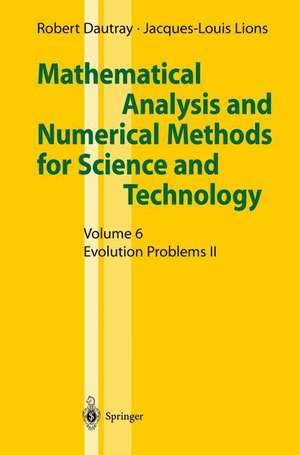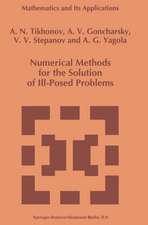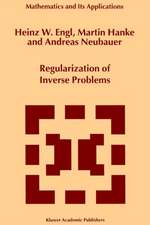Mathematical Analysis and Numerical Methods for Science and Technology: Volume 6 Evolution Problems II
Contribuţii de C. Bardos Autor Robert Dautray Traducere de A. Craig Revizuit de I.N. Sneddon Autor Jacques Louis Lions Contribuţii de M. Cessenat, A. Kavenoky, P. Lascaux, B. Mercier, O. Pironneau, B. Scheurer, R. Sentisen Limba Engleză Paperback – 22 noi 1999
| Toate formatele și edițiile | Preț | Express |
|---|---|---|
| Paperback (6) | 471.93 lei 38-44 zile | |
| Springer Berlin, Heidelberg – 22 noi 1999 | 471.93 lei 38-44 zile | |
| Springer Berlin, Heidelberg – 22 noi 1999 | 471.98 lei 38-44 zile | |
| Springer Berlin, Heidelberg – 22 noi 1999 | 476.18 lei 38-44 zile | |
| Springer Berlin, Heidelberg – 22 noi 1999 | 480.71 lei 38-44 zile | |
| Springer Berlin, Heidelberg – 22 noi 1999 | 487.73 lei 38-44 zile | |
| Springer Berlin, Heidelberg – 22 noi 1999 | 494.18 lei 38-44 zile |
Preț: 471.93 lei
Preț vechi: 589.92 lei
-20% Nou
Puncte Express: 708
Preț estimativ în valută:
90.33€ • 98.15$ • 75.93£
90.33€ • 98.15$ • 75.93£
Carte tipărită la comandă
Livrare economică 17-23 aprilie
Preluare comenzi: 021 569.72.76
Specificații
ISBN-13: 9783540661023
ISBN-10: 3540661026
Pagini: 500
Ilustrații: 1
Dimensiuni: 155 x 235 x 26 mm
Greutate: 0.7 kg
Ediția:2000
Editura: Springer Berlin, Heidelberg
Colecția Springer
Locul publicării:Berlin, Heidelberg, Germany
ISBN-10: 3540661026
Pagini: 500
Ilustrații: 1
Dimensiuni: 155 x 235 x 26 mm
Greutate: 0.7 kg
Ediția:2000
Editura: Springer Berlin, Heidelberg
Colecția Springer
Locul publicării:Berlin, Heidelberg, Germany
Public țintă
ResearchDescriere
The
object
ofthis
chapter
is
to
present
a
certain
number
ofresults
on
the
linearised
Navier-Stokes
equations.
The
Navier-Stokes
equations,
which
describe
the
motion
of
a
viscous,
incompressible
fluid
were
introduced
already,
from
the
physical
point
of
view,
in
§1
of
Chap.
IA.
These
equations
are
nonlinear.
We
study
here
the
equations
that
emerge
on
linearisation
from
the
solution
(u
=
0,
p
=
0).
This
is
an
interesting
exercise
in
its
own
right.
It
corresponds
to
the
case
of
a
very
slow
flow,
and
also
prepares
the
way
for
the
study
of
the
complete
Navier-Stokes
equations.
This
Chap.
XIX
is
made
up
of
two
parts,
devoted
respectively
to
linearised
stationary
equations
(or
Stokes'
problem),
and
to
linearised
evolution
equations.
Questions
of
existence,
uniqueness,
and
regularity
of
solutions
are
considered
from
the
variational
point
of
view,
making
use
of
general
results
proved
elsewhere.
The
functional
spaces
introduced
for
this
purpose
are
themselves
of
interest
and
are
therefore
studied
comprehensively.
Cuprins
XIX.
The
Linearised
Navier-Stokes
Equations.-
§1.
The
Stationary
Navier-Stokes
Equations:
The
Linear
Case.-
1.
Functional
Spaces.-
2.
Existence
and
Uniqueness
Theorem.-
3.
The
Problem
of
L?
Regularity.-
§2.
The
Evolutionary
Navier-Stokes
Equations:
The
Linear
Case.-
1.
Functional
Spaces
and
Trace
Theorems.-
2.
Existence
and
Uniqueness
Theorem.-
3.
L2-Regularity
Result.-
§3.
Additional
Results
and
Review.-
1.
The
Variational
Approach.-
2.
The
Functional
Approach.-
3.
The
Problem
of
L?
Regularity
for
the
Evolutionary
Navier-Stokes
Equations:
The
Linearised
Case.-
XX.
Numerical
Methods
for
Evolution
Problems.-
§1.
General
Points.-
1.
Discretisation
in
Space
and
Time.-
2.
Convergence,
Consistency
and
Stability.-
3.
Equivalence
Theorem.-
4.
Comments.-
5.
Schemes
with
Constant
Coefficients
and
Step
Size.-
6.
The
Symbol
of
a
Difference
Scheme.-
7.
The
von
Neumann
Stability
Condition.-
8.
The
Kreiss
Stability
Condition.-
9.
The
Case
of
Multilevel
Schemes.-
10.
Characterisation
of
a
Scheme
of
Order
q.-
§2.
Problems
of
First
Order
in
Time.-
1.
Introduction.-
2.
Model
Equation
for
x
?
?.-
3.
The
Boundary
Value
Problem
for
Equation.-
4.
Equation
with
Variable
Coefficients
and
Schemes
with
Variable
Step-Size.-
5.
The
Heat
Flow
Equation
in
Two
Space
Dimensions.-
6.
Alternating
Direction
and
Fractional
Step
Methods.-
7.
Internal
Approximation
Schemes.-
8.
Integration
of
Systems
of
Stiff
Differential
Equations.-
9.
Comments.-
§3.
Problems
of
Second
Order
in
Time.-
1.
Introduction.-
2.
The
Model
Equation
for
x
?
?.-
3.
The
Wave
Equation
in
Two
Space
Dimensions.-
4.
Internal
Approximation
Schemes.-
5.
The
Newmark
Scheme.-
6.
The
Wave
Equation
with
Viscosity.-
7.
The
Wave
Equation
Coupled
to
a
Heat
Flow
Equation.-
8.
Comments.-
§4.
The
Advection
Equation.-
1.
Introduction.-
2.
Some
Explicit
Schemes
for
the
Cauchy
Problem
in
One
Space
Dimension.-
3.
Positive-Type
Schemes
and
Stable
Schemes
in
LX(?).-
4.
Some
Explicit
Schemes.-
5.
The
Problem
with
Boundary
Conditions.-
6.
Phase
and
Amplitude
Error.
Schemes
of
Order
Greater
than
Two.-
7.
Nonlinear
Schemes
for
the
Equation.-
8.
Difference
Schemes
for
the
Cauchy
Problem
with
Many
Space
Variables.-
§5.
Symmetric
Friedrichs
Systems.-
1.
Introduction.-
2.
Summary
of
Symmetric
Friedrichs
Systems.-
3.
Finite
Difference
Schemes
for
the
Cauchy
Problem.-
4.
Approximation
of
Boundary
Conditions
in
the
Case
where
?
=
]0,
1
[.-
5.
Maxwell’s
Equations.-
6.
Remarks.-
§6.
The
Transport
Equation.-
1.
Introduction.-
2.
Stationary
Equation
in
One-Dimensional
Plane
Geometry.-
3.
The
Evolution
Equation
in
One-Dimensional
Plane
Geometry.-
4.
The
Equation
in
One-Dimensional
Spherical
Geometry.-
5.
Iterative
Solution
of
Schemes
Approximating
the
Transport
Equation.-
6.
The
Two-Dimensional
Equation.-
7.
Other
Methods.-
8.
Comments.-
§7.
Numerical
Solution
of
the
Stokes
Problem.-
1.
Setting
of
Problem.-
2.
An
Integral
Method.-
3.
Some
Finite
Difference
Methods.-
4.
Finite
Element
Methods.-
5.
Some
Methods
Using
the
Stream
function.-
6.
The
Evolutionary
Stokes
Problem.-
XXI.
Transport.-
§1.
Introduction.
Presentation
of
Physical
Problems.-
1.
Evolution
Problems
in
Neutron
Transport.-
2.
Stationary
Problems.-
3.
Principal
Notation.-
§2.
Existence
and
Uniqueness
of
Solutions
of
the
Transport
Equation.-
1.
Introduction.-
2.
Study
of
the
Advection
Operator
A
=
-
v.
?.-
3.
Solution
of
the
Cauchy
Transport
Problem.-
4.
Solution
of
the
Stationary
Transport
Problem
in
the
Subcritical
Case.-
Summary.-
Appendix
of
§2.
Boundary
Conditions
in
Transport
Problems.
Reflection
Conditions.-
§3.
Spectral
Theory
and
Asymptotic
Behaviour
of
the
Solutions
of
Evolution
Problems.-
1.
Introduction.-
2.
Study
of
the
Spectrum
of
the
Operator
B
=
-
v.
?
-
?.-
3.
Study
of
the
Spectrum
of
the
Transport
Operator
in
an
Open
Bounded
Set
X
of
?n.-
4.
Positivity
Properties.-
5.
The
Particular
Case
where
All
the
Eigenvalues
are
Real.-
6.
The
Spectrum
of
the
Transport
Operator
in
a
Band.
The
Lehner-Wing
Theorem.-
7.
Study
of
the
Spectrum
of
the
Transport
Operator
in
the
Whole
Space:
X
=
?n.-
8.
The
Spectrum
of
the
Transport
Operator
on
the
Exterior
of
an
“Obstacle”.-
9.
Some
Remarks
on
the
Spectrum
of
T.-
Summary.-
Appendix
of
§3.
The
Conservative
Milne
Problem.-
§4.
Explicit
Examples.-
1.
The
Stationary
Transport
Problem
in
the
Whole
Space
?.-
2.
The
Evolutionary
Transport
Problem
in
the
Whole
Space.-
3.
The
Stationary
Transport
Problem
in
the
Half-Space
by
the
Method
of
“Invariant
Embedding”.-
4.
Case’s
Method
of
“Generalised
Eigenfunctions”.
Application
to
the
Critical
Dimension
in
the
Case
of
a
Band.-
§5.
Approximation
of
the
Neutron
Transport
Equation
by
the
Diffusion
Equation.-
1.
Physical
Introduction.-
2.
Approximation
in
the
Case
of
a
Monokinetic
Model
of
Evolution
Equations
and
of
Stationary
Transport
Equations.-
3.
Generalisation
of
Section
2.-
4.
Calculation
of
a
Corrector
for
the
Stationary
Problem
and
Extrapolation
Length.-
5.
Convergence
of
the
Principal
Eigenvalue
of
the
Transport
Operator.-
6.
Calculation
of
a
Corrector
for
the
Principal
Eigenvalue
of
the
Transport
Operator.-
7.
Application
to
a
Critical
Size
Problem.-
8.
Numerical
Example
in
the
Case
of
a
Band.-
Appendix
of
§5.-
Perspectives.-
Orientation
for
the
Reader.-
List
of
Equations.-
Table
of
Notations.-
Cumulative
Index
of
Volumes
1-6.-
of
Volumes
1-5.



















